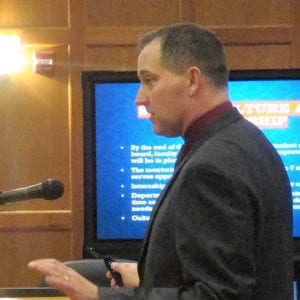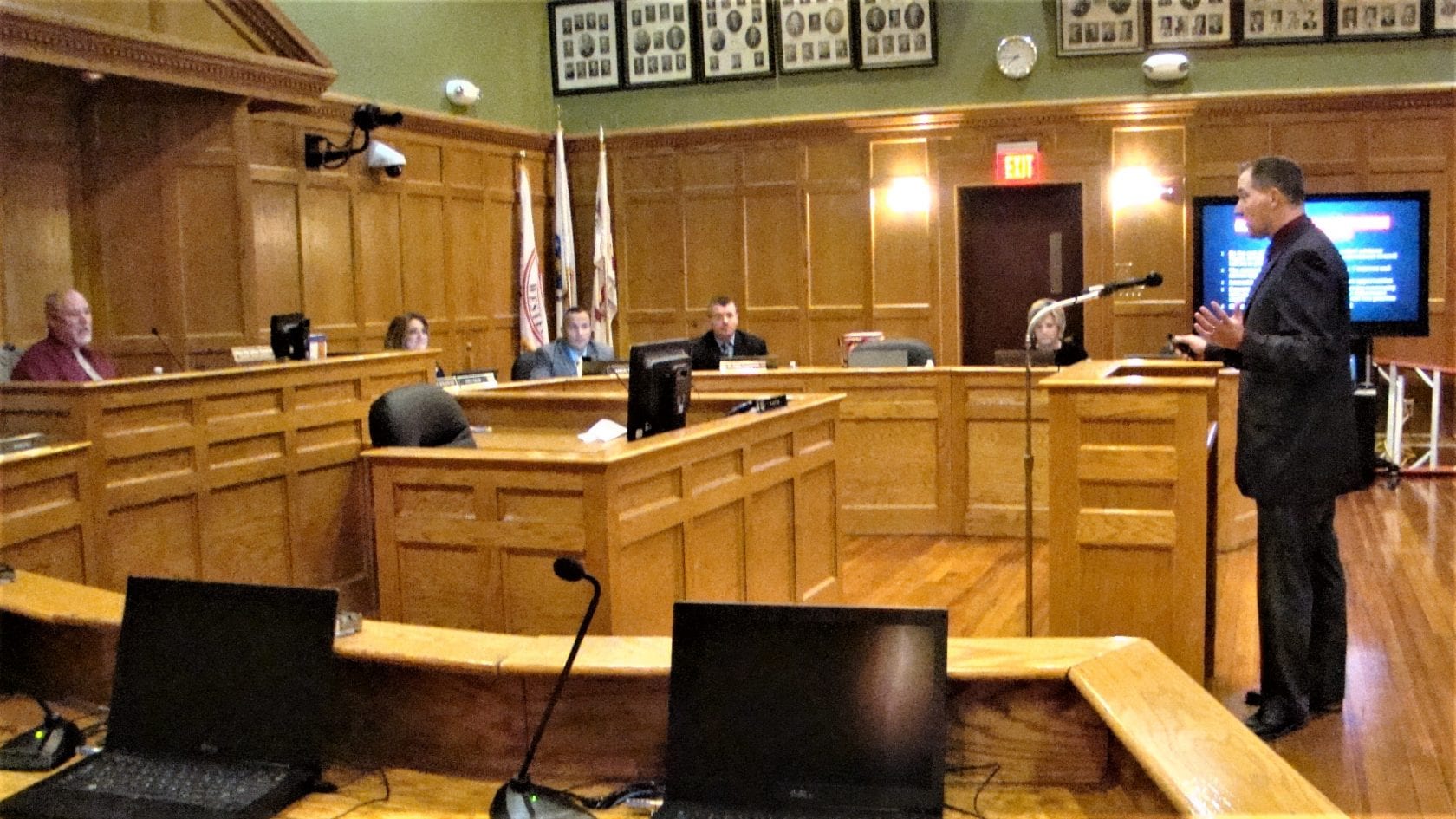
WHS Principal Charles Jendrysik presents the School Committee with a summary of the NEASC report. (Photo by Amy Porter)
WESTFIELD – Westfield High School Principal Charles Jendrysik gave a summary to the School Committee on Monday about the 100 plus page report from the New England Association of Schools and Colleges (NEASC), who visited and evaluated the high school last year. “It’s a lot to take in,” Jendrysik said.
He said NEASC gave both recommendations and commendations to the school on seven standards, which included Core Values, Curriculum, Instruction, Assessment, Student Culture and Leadership, School Resources for Learning and Community Resources for Learning.
Jendrysik said the school was commended on the presence of values and beliefs about learning among the staff, students and administration. Recommendations included defining learning expectations, and revising the school’s core values and school-wide 21st century expectations based on research, data and priorities of the school, district and community.
“We haven’t really had a deep look at core values,” said Jendrysik, who is in his third year as principal of Westfield High School. He said they have now begun the process and will continue for the next three years with input from all of the stakeholders, including the leadership team, Student Advisory Council, Student Improvement Council and staff input. He said he has confidence in his leadership team, which has been in place for three years.
Jendrysik also mentioned the school’s involvement in the Westfield Education 2 Business Alliance, and the 20 students now doing internships in the community.
Regarding curriculum, the school was commended on the willingness of teachers to engage individually and by department in developing the curriculum. Recommendations include providing more time for staff to do this work. Jendrysik said there is ongoing professional development with the International Center for Leadership in Education, and they have formed a school data team to guide the school in teaching and learning.
The school continues to use the software program “Navience” to gauge student interests and strengths in terms of potential careers. He also mentioned Westfield Promise, the ongoing collaboration with Westfield State University. “We have a very good relationship with Westfield State University and with a number of other colleges and universities,” he said, also citing the work done by the Reed Career Center.
This year, WHS is piloting a new course called 21st Century Learning Skills, taught by Family Consumer Science Teacher Margaret Toomey. He said the course focuses on work readiness skills, such as interviews, and gets students out in the community, including a visit this Thursday at a therapeutic riding school.
Under instruction, NEASC commended teachers’ efforts to maximize limited technology. Jendrysik said since the NEASC visit, they have expanded the technology in the school with 400 student Chromebooks and 25 teacher Chromebooks. They have also launched the BYOD (Bring Your Own Device) program. Jendrysik admitted that he was skeptical at first that students would use their devices appropriately, but he said it is working out, and giving the school an opportunity to do more with technology.
He said they also spent $700,000 this year on supplies for teachers, including projectors, etc., adding that the situation “is far better than when they (NEASC) visited.”
Jendrysik said they are also doing formative assessments on student learning. He said the Student Teacher Assistance Team meets every two weeks to identify students who are in need of assistance.
“NEASC has informed some of the directions we’re taking,” Jendrysik said.
Jendrysik said one commendation they received under School Culture and Leadership was inclusion of Special Education students in regular education classrooms. “This is near and dear to my heart,” he said.
The school has also expanded its mentoring program to seven mentors who are mentoring 75 students; and has added an additional guidance counselor, another recommendation in the report.
Jendrysik said the school is currently working on four major grants in the areas of special needs, access, early college opportunities with Westfield State, and 21st century learning. They are also developing a long-range plan for staffing, faculty needs, technical and capital improvements.
Two improvements in the works are a new roof, which recently received a $500,000 spending approval from the City Council from unspent funds in the Cross St. Bond, and a new expanded front door entry way. Jendrysik said the district has a very supportive superintendent and central office team. “I appreciate that very much,” he said.
He also pointed to Volunteers in Public Schools coordinator Tina Macy, and her partnership with The Westfield Bank and the Polish National Credit Union in the upcoming Credit for Life program.
“We honestly have a great school with a staff who works hard. Everyone is really coming together nicely,” Jendrysik said. He said they don’t have an updated mission yet, but they have all the tools.
“We have work to do. I know we have all the tools and the staff to meet the need,” he said, adding that they also have ten years before the next NEASC visit. He said moving forward, their focus is on core values, beliefs and expectations to drive curriculum.
“I did read the report – the most confusing report I ever read,” said School Committee vice-chair Cindy Sullivan, adding that she didn’t know how to get all of its information out to stakeholders.
Sullivan said the report noted the turnover of principals and staff at the school, saying to Jendrysik, “You’ve been great in your consistency.” She said she was disappointed that it did not highlight some of the activities going on at the school, some of which she spoke to them about. She said there is great information in the report, but “it needs to be taken with a grain of salt. They missed a lot. I just had a daughter graduate who is an honor student,” Sullivan said.
Jendrysik said he and Superintendent Stefan Czaporowski will be meeting with the associate commissioner of the NEASC in January to go over the report and seek some clarifications. He also noted that the NEASC missed a whole day of visits due to a snow day, which was not rescheduled.
School Committee member Heather Sullivan, who also said she read the entire report, thought a few of the recommendations were good, but balked at ones for additional assessments and testing. “I’m frustrated with hearing how many times they want you to test and asses.”
“The challenge is to find the happy medium,” Jendrysik said, adding too many assessments take the fun out of teaching. He also pointed to the progress in new special education programs. “I’ve seen the difference in just one year,” he said.
“You have a great group of people who are putting kids first. You can see it all coming together,” she said.
“It was a confusing report; hard to figure out the direction the team was trying to take. For me, this should be a comprehensive report,” said School Committee member Timothy O’Connor. He asked what Jendrysik hoped to get out of the meeting with the NEASC official.
“More clarification – I don’t know that they’ll make any subsequent changes,” Jendrysik said.
O’Connor asked whether there were additional expenses attached to the recommendations. Jendrysik said there were expenses regarding facilities; including new science labs, and the roof. O’Connor also asked if they recommended anything not already on the radar.
“The biggest thing is 21st century learning. We need to do this; we need to make our students and classes ready for the skills that they will need,” Jendrysik said.
“I think it was a long way of saying you’re doing a good job, but there’s room for improvement,” said O’Connor.


